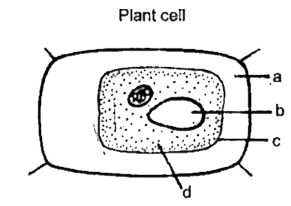A plant cell shrinks when it is kept in
Hypotonic solution
Hypertonic solution
Isotonic solution
Water
The correct Answer is:2
To determine when a plant cell shrinks, we need to understand the effects of different types of solutions on plant cells. Here’s a step-by-step solution to the question:
Step 1: Understand the Types of Solutions
- Hypotonic Solution: This solution has a lower concentration of solutes compared to the inside of the cell. When a plant cell is placed in a hypotonic solution, water enters the cell, causing it to swell (endosmosis).
- Hypertonic Solution: This solution has a higher concentration of solutes compared to the inside of the cell. When a plant cell is placed in a hypertonic solution, water leaves the cell, leading to shrinkage (exosmosis).
- Isotonic Solution: This solution has an equal concentration of solutes compared to the inside of the cell. When a plant cell is placed in an isotonic solution, there is no net movement of water, and the cell remains unchanged.
- Water: Pure water can be considered a hypotonic solution for plant cells, as it has no solutes. Therefore, a plant cell placed in pure water will swell.
Step 2: Analyze the Question
The question asks in which type of solution a plant cell shrinks. Based on our understanding of the solutions:
- In a hypotonic solution, the cell swells.
- In an isotonic solution, the cell remains the same.
- In water, the cell also swells.
- In a hypertonic solution, the cell shrinks.
Step 3: Conclusion
From the analysis, we can conclude that a plant cell shrinks when it is placed in a hypertonic solution. Therefore, the correct answer is:
Option 2: Hypertonic solution.
---
- Hypotonic Solution: This solution has a lower concentration of solutes compared to the inside of the cell. When a plant cell is placed in a hypotonic solution, water enters the cell, causing it to swell (endosmosis).
- Hypertonic Solution: This solution has a higher concentration of solutes compared to the inside of the cell. When a plant cell is placed in a hypertonic solution, water leaves the cell, leading to shrinkage (exosmosis).
The question asks in which type of solution a plant cell shrinks. Based on our understanding of the solutions:
- In an isotonic solution, the cell remains the same.
- In water, the cell also swells.
- In a hypertonic solution, the cell shrinks.
From the analysis, we can conclude that a plant cell shrinks when it is placed in a hypertonic solution. Therefore, the correct answer is:
Topper's Solved these Questions
- SOLUTIONSBOOK - AAKASH INSTITUTE ENGLISHCHAPTER - SOLUTIONSEXERCISE - ASSIGMENT (SECTION-B)
21 Videos
- SOLUTIONSBOOK - AAKASH INSTITUTE ENGLISHCHAPTER - SOLUTIONSEXERCISE - ASSIGMENT (SECTION-C )
11 Videos
- SOLUTIONSBOOK - AAKASH INSTITUTE ENGLISHCHAPTER - SOLUTIONSEXERCISE - TRY YOURSELF
14 Videos
- REDOX REACTIONSBOOK - AAKASH INSTITUTE ENGLISHCHAPTER - REDOX REACTIONSEXERCISE - ASSIGNMENT SECTION - D
10 Videos
- SOME BASIC CONCEPT OF CHEMISTRYBOOK - AAKASH INSTITUTE ENGLISHCHAPTER - SOME BASIC CONCEPT OF CHEMISTRYEXERCISE - ASSIGNMENT( SECTION - D) Assertion-Reason Type Questions
15 Videos
Similar Questions
Explain what will happen to a plant cell if it is kept in a solution having higher water potential
View SolutionWhat happens to a plant cell when it is placed in a hypotonic solution ?
View SolutionA plant cell when kept in a certain solution got plasmolysed. What was the nature of the solution ?
View SolutionIn a plant cell DPD is zero when it is
View SolutionStudy the diagram given alongside showing a plant cell kept in a strong sugar solution.

What will happen to this cell if it is kept in water?
View SolutionA plant cell has potential to develop into full plant. This property of the plant cell is called
View SolutionA plant cell is kept in a hypotonic solution. What will happen to the solute potential of this cell?
View SolutionIf a mango shrinks when kept in concrete salt solution, then which of the following process take place?
View SolutionA cell swells up when kept in
View SolutionWhy do plant cells not burst when placed in water?
View Solution
